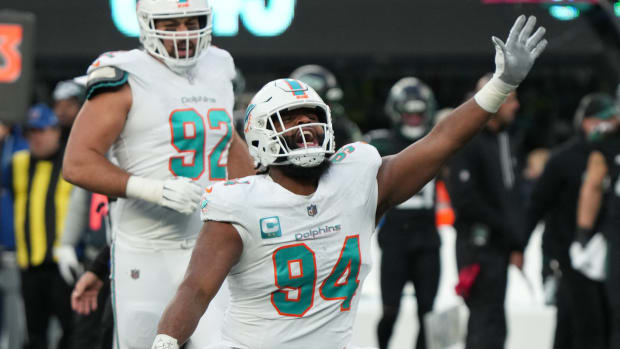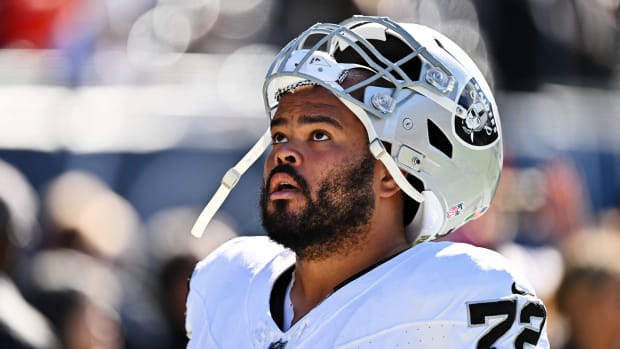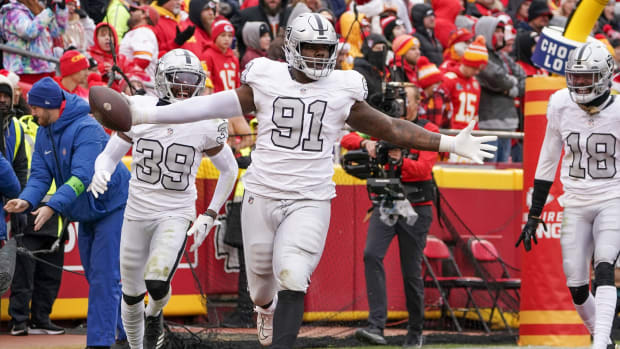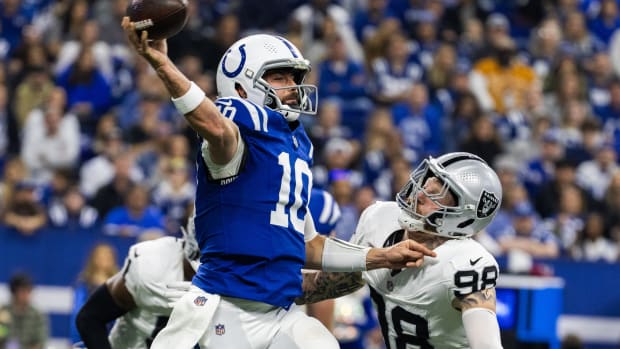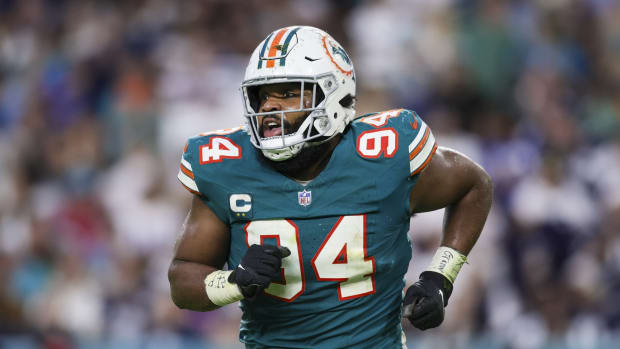Raiders All-Time Top Five: Wide Receivers
1. Fred Biletnikoff, 1965-1978
Although Fred Biletnikoff wasn’t even close to being one of the biggest or fastest wide receivers in NFL history, he unquestionably was one of the very best. The 6-1, 190-pound Biletnikoff was drafted by the Raiders in the second round (No. 11 overall) of the 1965 American Football League Draft by the Raiders and in the third round (No. 39 overall) of the National Football League Draft by the Detroit Lions out of Florida State. Raiders Coach and General Manager Al Davis signed Freddie B. under the goalpost after the Seminoles’ 36-19 victory over Oklahoma in the Gator Bowl, in which he caught 13 passes for 194 yards and four touchdowns. Biletnikoff had 100 receptions for 1,655 yards and 20 touchdowns at Florida State, all school records at the time, and was a consensus All-American as a senior. However, he was only getting started. Biletnikoff played mostly on special teams in the first six games of his rookie season with the Raiders in 1965, but in the seventh game against the Boston Patriots, he caught seven passes for 118 yards and simply kept getting better. Over 14 seasons with the Silver and Black, Biletnikoff made 589 receptions for 8,974 yards, a 15.2-yard average, and 76 touchdowns on his way to the Pro Football Hall of Fame. In addition, he caught 70 passes for 1,167 yards and 10 touchdowns in 19 post-season games—all NFL playoff records at the time. He was a two-time All-AFL selection, made the Pro Bowl in the first four seasons after the AFL-NFL merger was complete, and was selected All-Pro in 1972. And it didn’t matter if Tom Flores, Daryle Lamonica, or Kenny “Snake” Stabler was the Raiders quarterback. When the Raiders beat the Minnesota Vikings, 32-14, in Super Bowl XI, Biletnikoff made four catches for 79 yards, taking three of them inside the two-yard line to set up touchdowns, and was selected the game’s Most Valuable Player. After retiring from the Raiders in 1978 and playing one season with the Montreal Alouettes of the Canadian Football League in 1980, Biletnikoff spent more than 20 years coaching receivers, including with the Raiders from 1989-2006. He and his wife, Angela, operate the Biletnikoff Foundation, a non-profit organization, which is dedicated to supporting young people, primarily from low-to-moderate income neighborhoods or backgrounds.
2. Tim Brown, 1988-2003
Even though Brown earned every award possible as a senior at Notre Dame in 1987, the Raiders somehow were able to select him with the sixth pick in the first round of the NFL Draft and he later showed that perhaps he should have gone No. 1 or 2. He won the Heisman Trophy and the Walter Camp Award, and was UPI and the Sporting News Player of the Year, in addition to being a consensus All-American as a senior. That season, he caught 34 passes for 846 yards and three touchdowns, returned 34 punts for 401 yards and three scores, rushed for 144 yards and a TD, and gained 456 yards on 23 kickoff returns. Brown finished his career at Notre Dame with 137 receptions for 2,493 yards, a school record of 5,024 all-purpose yards, and 22 touchdowns. He was only getting warmed up. Brown caught 47 passes for 725 yards and five touchdowns as a rookie but was slowed by injuries the next few seasons before really taking off. He made at least 76 receptions for more than 1,000 yards in nine consecutive seasons from 1993-2001, including career-bests of 104 catches for 1,408 yards and in 1997. The 6-foot, 195-pound Brown is the Raiders all-time leading receiver with 1,070 receptions for 14,734 yards and 99 touchdowns, adding three TDs on punt returns (one for 88 yards), one on a kickoff return and another on a six-yard run. Brown was selected to nine Pro Bowls, was second-team All-Pro in 1996 and 1997, was the NFL co-leader in receptions in 1997, was chosen to the NFL 1990s All-Decade Team, and was overdue when he was voted into the Pro Football Hall of Fame in 2015. Brown was released by the Raiders in 2004 and signed with the Tampa Bay Buccaneers, making the 100th touchdown reception of his career in a game at the Oakland Coliseum. He signed a one-day contract with the Raiders the next year before retiring as a member of the Silver and Black.
3. Cliff Branch, 1972-1986
As a wide receiver at Colorado, Branch had one duty, to run deep with his sprinter’s speed. Fortunately, he was selected by the Raiders in the fourth round (No. 98) overall of the 1972 NFL Draft and was able to learn the art of his craft from the master, Fred Biletnikoff. After finishing second in the 100-meter dash with a time of 10.0 seconds in the 1972 NCAA Track and Field Championships, Branch passed up a chance to try out for the United States Olympic team that year in order to report on time to training camp with the Raiders. The 5-11, 170-pound Branch mastered the short and medium patterns that Biletnikoff ran to perfection and still was able to beat single, double, and sometimes even triple coverage deep down the field. In his 15 seasons with the Raiders, Branch caught 501 passes, third-best in team history, for 8,685 yards, a 17.3-yard average, and 67 touchdowns, including a 99-yarder from Jim Plunkett in a game against the Washington Redskins in 1983. The Raiders lost that game, 37-35, but got their revenge against the Redskins at the end of that season with a 38-9 victory in Super Bowl XVIII, when Branch caught six passes for 94 yards and a touchdown. Branch played a key role in all three of the Raiders' victories in the Super Bowl, making five catches for 67 yards and two touchdowns in SB XV against the Philadelphia Eagles. In a 32-14 victory over the Minnesota Vikings in Super Bowl XI, Branch caught only one pass for 11 yards as the Eagles watched him closely. However, that helped open up the Raiders running game that went for 266 yards, left the middle clear for tight end Dave Casper to catch four passes for 70 yards and a touchdown, and helped Biletnikoff get open to catch three passes that went inside the two-yard line to set up touchdowns. When Branch retired in 1985, he led the NFL with 73 receptions and 1,289 yards in post-season games, averaging 17.7 yards per catch and scoring five touchdowns. He was selected to the All-Pro team four times and played in four Pro Bowls. Branch retired from the Raiders in 1986, but played one season with the Los Angeles Cobras in 1998 and showed he hadn’t lost it, catching 25 passes for 250 yards and three touchdowns. Branch died two days after his 71st birthday in 2019, and still has not been voted into the Pro Football the Hall of Fame despite having better statistics than several wide receivers already enshrined—despite being a semi-finalist three times.
4. Art Powell, 1963-1966
Powell, who played only four memorable seasons with the Raiders, is one of several forgotten former American Football League stars who deserve consideration for the Pro Football Hall of Fame. The 6-3, 210-pound Powell was drafted by the Philadelphia Eagles in the 11th round (No. 123 overall) out of San Jose State in the 1959 National Football League Draft after leaving college early and playing the previous two seasons with the Montreal Alouettes and Toronto Argonauts of the Canadian Football League. He made 33 catches for 647 yards and three touchdowns in the CFL, but it wasn’t until he signed with the New York Titans in 1960 that a team took advantage of his receiving skills. Powell caught 69 passes for 1,1167 yards, the first of his 1,000-yard-plus five seasons, for an AFL-leading 14 touchdowns in the league’s inaugural season. After he made 204 catches for 3,178 yards and 27 touchdowns in three seasons for the Jets, Coach, and General Manager Al Davis brought him to Oakland in 1963 and hooked him up with quarterback Tom Flores. Powell caught 254 passes for 4,491 yards, a 17.7-yard average, and 50 touchdowns in four years with the Raiders, including 73-1,304-16 in 1963, when the Silver and Black went from 1-13 the year before to 10-4. He is still the fourth-leading receiver in team history. In addition, Powell and teammates Clem Daniels, Bo Roberson, and Fred Williamson led a boycott of a preseason game in Mobile, Ala., because of segregated seating at Ladd Stadium, Coach Davis backed them up and the game wasn’t played. However, in 1967 Davis traded Powell and Flores to the Buffalo Bills for quarterback Daryle Lamonica. Powell played that season with the Bills and one more with the Minnesota Vikings before retiring with a total of 479 receptions for 8,046 yards and 81 touchdowns. He played in four AFL All-Star Games, was voted All-AFL six times, and was named to the All-Time AFL Team. Powell died in 2015 at the age of 78.
5. Warren Wells, 1967-70
Longtime members of Raider Nation will always wonder what might have been when it comes to Wells, who was a shooting star who flamed out after four seasons—three of them absolutely brilliant. The 6-1, 190-pound Wells was selected in the 12th round of the 1964 NFL Draft out of Texas Southern by the Detroit Lions. He caught two passes for 19 yards as a rookie with the Lions that year, but was drafted and spent a two-year stint in the U.S. Army. Wells wound up on the taxi squad of the Kansas City Chiefs in 1967. Coach and General Manager Al Davis was watching film of a Chiefs preseason game and saw what he thought looked like the great Otis Taylor playing wide receiver on both sides of the field. When the Chiefs tried to sneak Wells through waivers, Davis and the Raiders grabbed him. After making 13 catches for 302 yards and six touchdowns from quarterback Daryle Lamonica in 1967, Wells put together three incredible seasons, starting in 1968 with 53 catches for 1,137 yards, a 21.5-yard average, and 11 touchdowns, including a 94-yarder. The next year he caught 47 passes for 1,260 yards, a whopping 26.8-yard average, and 14 TDs, and added 43 catches for 935 yards and 11 scores in 1970. Wells was an All-AFL All-Star in 1968, led the league in receptions and touchdowns in 1969, and played in the 1970 Pro Bowl in the first year after the AFL-NFL merger was complete. Hall of Famer Fred Biletnikoff, who played opposite Wells, called him the best receiver he has ever seen. But, tragically, that was it. Following the Pro Bowl game at the Los Angeles Coliseum, Wells was met by police in the locker room and arrested on a warrant for a probation violation originating from his conviction in 1969 for aggravated assault against a woman. Wells had pleaded guilty after being accused of attempting to rape the woman, and in 1970 he violated his parole by drinking in a bar, where he was involved in a fight during which another woman stabbed him in the chest. Shortly after, Wells was sentenced to a year in prison and was released after 10 months. As part of his sentence, Wells was to spend the next six months at a drug rehabilitation center known as Synanon. When he returned to the Raiders, he was nothing like the athlete he had been, his drive was gone, and the Raiders released him. Wells, a drug addict, and alcoholic returned to his childhood home of Beaumont, Texas, where he was arrested for robbery in 1976 while panhandling. However, later in life, he kicked his habits and returned to Oakland in 2017, when he attended the 50th reunion of the Raiders’ 1967 AFL Championship team and was honored along with his teammates during an on-field ceremony. In 2015, Wells lit the Al Davis Memorial Torch before a game against the Green Bay Packers. However, Wells suffered from dementia and died of a heart attack in 2018 at the age of 76.
Please make sure you tell us your thoughts when you like our Facebook Page WHEN YOU CLICK RIGHT HERE.
Want the latest breaking Las Vegas Raiders news delivered straight to you? CLICK THE FOLLOW button on the top of the page. Don't miss any of the latest up to the second updates for your Las Vegas Raiders when you follow on Twitter @HondoCarpenter, @HikaruKud1
